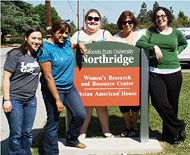|
|||||||
|
Skip Navigation | ||||||
|
Some things remain
Imagine this for a moment, if you will… from 7:00pm – 9:00pm Monday through Friday, during the hot summer Northridge months, students come to your office to hang out, get advice from and connect with their peers, and access resources and referrals for concerns such as emergency housing, employment, sex discrimination, legal aid, child care needs, and so on. In 1973, one brave faculty member, Dr. Margaret Vernallis, allowed what was then a small vision with a big heart to operate out of her office for the summer months. Students in a CSUN speech class titled "Women as a Rhetorical Force" discovered a need to create a Women’s Center on campus. At the time, their main goal was the Center itself, but their underlying objective was to unite women. They had a hunch, if you build it, they will come. And so they did! In 1974, the CSUN Women's Center officially opened its doors to a burgeoning community of students eager to connect to one another and create change. Thirty-six years later, it is evident those students were onto something. Times change, addresses change, names change, students change, and even faculty change, but some things are quite consistent: students are hungry for a campus community, for academic support, for personal connection and for an opportunity to positively contribute to a civil society. And so from the small office in the Administration Building to Etiwanda Ave. to Plummer St. to Halsted St. they went. From the Women’s Center to the Women’s Resource Center to the Women’s Research and Resource Center they went. Here we are now, 36 years, 4 addresses and 3 name changes later, and I ask myself, has anything really changed? I am often asked, do we even need a Center like this anymore? And I cringe at the thought of it disappearing. Not because I was a student volunteer in 2000, not because I was the student Director in 2001, and not even because I am the Faculty Director now, but because as long as 1 in 4 women are sexually assaulted we need a Center like this. As long as women struggle to find fair employment, affordable housing and access to child and health care, we need a Center like this. As long as men contend with a system that perpetuates violence, we need a Center like this. As long as discrimination and exclusion exist, we need a Center like this. And so, I simply say, "yes," of course there is still the need for a Center like this on our campus, and in our community. So, while it appears superficially that a lot has changed, clearly, some things remain. Come see what we are doing over at the Women’s Research and Resource Center about that. For more information visit us on the web at: — Submitted by Shira BrownCollege of Humanities shares in $8.4 million federal grant awarded to CSUNIn April 2010, the U.S. Department of Education announced that CSUN was awarded a Teacher Quality Partnership grant. During this funding cycle, "CSUN is the only university in California to have earned this extremely important and prestigious federal grant," according to Dr. Michael Spagna, Dean, Michael D. Eisner College of Education. This project addresses the critical shortage of qualified special education teachers prepared to serve learners in high-need schools through a partnership between the Los Angeles Unified School District (LAUSD) and the Colleges of Education and Humanities at CSUN. The specific project objectives are to: 1) Recruit a total of 150 promising special education teachers (30 each year for five years). 2) Develop and implement a model, 18-month credential/M.A. teaching residency program that (a) incorporates the new California special education standards emphasizing diversity and English learners, technology integration, and collaboration; (b) provides a concentration in language and literacy; (c) implements a one-year apprenticeship alongside experienced and trained special education mentors; and (d) creates a data-driven professional community of learners which promotes evidence-based practices and enhanced academic student achievement. 3) Enhance teacher retention through a two-year induction program that includes support in high-need schools and participation in teacher inquiry groups with mentors, examining pupil learning. Faculty from the College of Humanities, Drs. Evelyn McClave, Sharon Klein, and Rosa Furumoto, will serve on the language and literacy workgroup under the leadership of the Project Co-director Dr. Sue Sears. These faculty members will be responsible for developing the language/literacy concentration along with Dr. Sears. They have been selected for the project because of their expertise in linguistics, language development and literacy and involvement in serving pre K-12 students in high-need schools. The language and literacy workgroup will develop and revise courses for the credential/master’s degree, and design and implement professional development activities including a web-based module and workshop in language/literacy. — Submitted by Joshua Einhorn |
||||||
|
|
||||||
